|
|
| |
ITALY
SIENA
HISTORY, LANDMARKS, MUSEUMS AND GALLERIES
According to legend, Siena was founded by Senius, son of Remus, who was in turn the brother of Romulus, after whom Rome was named. Statues and other artwork depicting a she-wolf suckling the young twins Romulus and Remus can be seen all over the city of Siena.
Siena began as an Etruscan settlement and a small Roman town, and was the seat of a Christian bishop by the 5th century. Its importance began in the early 12th century, when a self-governing commune replaced the earlier aristocratic government.  Photo PKG
The consuls who governed the republic slowly became more inclusive of the poblani, or common people, and the Commune increased its territory as the surrounding feudal nobles in their fortified castles submitted to the urban power.
Siena's republic, struggling internally between nobles and the popular party, usually worked in political opposition to its great rival, Florence, and was in the 13th century predominantly Ghibelline in opposition to Florence's Guelph position (the backdrop for Dante's Commedia)
Siena's university, founded in 1203 and famed for its faculties of law and medicine, is still among the most important Italian universities. The picturesque city remains an important cultural centre, specially for humanist disciplines.  Photo PKG
Siena rivalled Florence in the arts through the 13th and 14th centuries. The important late medieval painter Duccio (1253–1319) was a Senese but worked across the peninsula, and the mural of "Good Government" by Ambrogio Lorenzetti in the Palazzo Pubblico, or town hall, is a magnificent example of late-Medieval/early Renaissance art as well as a representation of the utopia of urban society as conceived during that period.
Siena was devastated by the Black Plague of 1348 and never recovered its earlier glory, losing out to Florence in inter-urban rivalry. Siena retained its independence in Tuscany until 1557.
Siena's cathedral, the Duomo, begun in the 12th century, is one of the great examples of Italian gothic architecture. The shell-shaped Piazza del Campo, the town square, is another architectural treasure and is famous for hosting the Palio.
Piazza del Campo
Sienna is notable for its extremely well preserved urban center as many of the buildings have not changed since medieval times. The Piazza Del Campo, once the site of a Roman forum, early on became the city's central market place. It become the center for civic life with the construction of teh Town Hall in the 12th century (now the Civic Museum). Its spoke-like paving pattern was commissioned in 1349 by Siena's then ruling body, the Council of Nine, to symbolize their power and the nine folds of the Madonna's cloak.
 Photo PKGSince the Piazza's completion, it has remained the site of most of the city's public events, including bullfights, executions, festivals, and the famous Palio, a breakneck, bareback 90-second horserace that occurs twice a year.
The Palio delle Contrade
No other festival in Italy is as colourful, as intense, or as spectacular as Siena's Palio. Twice a year, Siena packs the Piazza del Campo with dirt, and runs a no-holds-barred bareback horse race around it. These races are the highlight of a full week of trial runs, feasts, parades, spectacles of skill, and solemn ceremonies. The tradition goes back to at least 1310.
The Palios rally start on June 29 and August 13. Although both races are technically equal in importance, the August Palio gets the most attention, partly because it is older, but mainly because it is a sort of rematch, the last chance to win for the year.
The Cathedral of Siena (Duomo di Siena)
The Cathedral of Siena dedicated from its earliest days as a Roman Catholic Marian church and now to Santa Maria Assunta (Most Holy Mary of Assumption).
 Photo PKGThe cathedral itself was originally designed and completed between 1215 and 1263 on the site of an earlier structure. It has the form of a Latin cross with a slightly projecting transept, a dome and a bell tower. The dome rises from an octagonal base with supporting columns. The lantern atop the dome, was added by Gian Lorenzo Bernini. The nave is separated from the two aisles by semicircular arches. The exterior and interior are constructed of white and greenish-black marble in alternating stripes, with addition of red marble on the façade. Black and white are the symbolic colors of Siena, etiologically linked to black and white horses of the legendary city's founders, Senius and Aschius.
Casa di Santa Caterina
The remarkable Caterina Benincasa, took a nun's veil in 1355, at the age of 8 (after her first of many visions of Christ). In 1375, a Crucifix in Pisa cinched her holiness by giving her the stigmata of Christ's wounds. Her name and reputation for devout wisdom and saintly life spread, and in 1939, she was declared patron saint of Italy. The house where she was born was converted into a sanctuary in 1466, and it remains a peaceful, reflective spot. The entrance is a small brick-lined courtyard, and beyond this is a small loggia built in 1533. Under the loggia, the stairs lead down past Catherine's cell, frescoed in 1896. The old family kitchen was transformed into an oratory and decorated in the 16th and 19th centuries. The church opposite the oratory was built in 1623 over Catherine's orchard, to house the 12th-century Pisan-school Crucifixion, in front of which the saint received the stigmata.
Admission to this site is free and it is situated between Via della Sapienza and Via Santa Caterina.
Sightseeing in Terza di Camollia
Siena's northern third spreads off either side of the palace-lined Via Banchi di Sopra. Two blocks up on the left is the oldest Gothic palace in the city, the Palazzo Tolomei, begun in 1208 and now home to the Cassa di Risparmio di Firenze bank. The piazza out front is where the city council met from the 11th century until the Palazzo Pubblico was built. Two blocks further is the piazza formed by the Gothic Palazzo Salimbeni and its tributary palaces. It is linked to form the seat of the Monte di Paschi di Siena, Siena's powerhouse bank, founded in 1472, and still a strong player in Italian finance (and the city's largest employer).
Oratorio di San Bernardino e Museo Diocesano
The church of San Francesco was built in the late 15th century. It houses the Oratory of San Bernardino, which marks the exact spot where St Bernardino prayed and began preaching. The lower level of the oratory was frescoed by the best 17th-century Sienese artists, including Francesco Vanni, Rutilio and Domenico Manetti, and Ventura Salimbeni. It also houses a little Madonna by Sano di Pietro. The upper level has higher-quality frescoes by 16th-century artists Sodoma, Domenico Beccafumi, and Girolamo del Pacchia. The rooms that make up the Diocesian Museum contain paintings and churchly artifacts. Just outside the gate you will find the 1262 Fonte Ovile, one of the city's most picturesque public fountains. The museum is open daily from 10:30am to 1:30pm, and 3 to 5:30pm (March 15 to October).
Palazzo Piccolomini
This 1469 palace was designed by Bernardo Rossellino in the Florentine Renaissance style. It is now home to the Archivio di Stato (head down the corridor off the left of the courtyard to grab the elevator to the 4th floor). The state archives preserve, among other notable documents, Boccaccio's will and Jacopo della Quercia's contract for the Fonte Gaia. The main thing to see is a remarkable set of wooden covers made for the city's account books, called the Tavolette di Biccerna, painted from the 13th to 17th centuries with religious scenes and important events in Siena's history. Open Monday through Saturday from 9am to 1pm, and admission is free. Located Via Banchi di Sotto 52.
Baptistry
The Duomo's baptistery was built in the 14th century, beneath the cathedral's choir, and supports a Gothic facade left unfinished by Domenico di Agostino (1355). What you are here to see, is the baptismal font (1417-30). The frames are basically Gothic, but the gilded brass panels were cast by the foremost Sienese and Florentine sculptors of the early Renaissance.
The final panel is perhaps the greatest, Donatello's masterful early study of precise perspective and profound depth in the Feast of Herod
The baptistery is open daily 9am to 7:30pm (March 15 - September); 9am to 6pm (October); and 10am to 5pm (November - March 14).
Park Hotel
The Park Hotel is your 16th century villa in the beautiful Tuscan countryside. All of the public rooms were totally renovated in 1991. In the reception rooms, bar, restaurant you will see splendid stone door surrounds, antique terra cotta floors and antique furnishings matching the style of the Villa. Although restored, the hotel maintains its original charm with authentic antique furniture. The hotels panoramic restaurant offers Tuscan cuisine. There is also an American bar. Sport facilities at the hotel include a large swimming pool and a tennis court. A short-game, executive golf course with 6 par 3 holes, is available in the park of the Hotel.
Osteria le Logge
The best choice for a special night out, offering excellent cooking in a sedate atmosphere. The taglierini al tartufo has a light butter sauce that does not mask the delicate flavour of the black truffles. Heavier primi include malfatti all'Osteria (spinach-and-ricotta balls in a creamy tomato sauce) and ravioli ripieni di pecorino e menta (ravioli stuffed with sheep's-milk cheese and mint, in a sauce flavoured with port).
Meatier palates can enjoy the bistecche di vitello (tender veal steaks) or delicate carpaccio di pesce spada affumicato (smoked swordfish sliced and pounded into thin disks). The staff are friendly and very accommodating.
Enoteca Italiana - Tourist Attraction
The 16th-century Fortezza Medicea has been turned into a public park. Its courtyard is an open-air theater, and it is a good place for a stroll and a view. Its vaults are filled with Italy's National Wine Museum. Seated at small tables in the tunnel-like brick halls or out on the terraces in summer, you can sample a choice selection of Tuscan and Italian wines by the glass, or go all out on an entire bottle from their extensive cantine (more than 1200 labels available). It has been Italy's official state-mandated Museo Del Vino since 1950. Admission to the venue is free.  Photo PKG
| |
|
Festivals & Events
Vinum Bonum
This is a very special period in Valley Veneggia just south of Bolzano and just north of the upper tip of Lake Garda. For the entire month of August there are musical concerts held in a variety of the 27 wine-gowing 'cantinas' in the valley selected by a governing board for the high quality of the wines they produce. The tastings all begin at 4:30 in the afternoon and conclude at 7:00 PM and are only held on Tuesdays, Thursdays and Fridays.
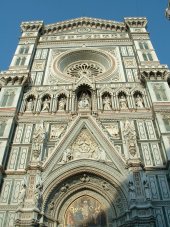 St. Maria del Fiore, Florence
Photo: BPG
International Piano Festival - Amalfi
July and August
The Chiostro del Paradiso is the setting for concerts by Italian and foreign pianists who alternate playing every Friday.
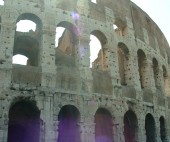 The Colosseum, Rome
Photo: BPG
MUSICAL WEEKS
Siena
August
Accademia Musicale Chigiana
Via di Città 89 - 53100 Siena
Tel. 39 0577 46152
Fax 39 0577 288124
Spoleto
June - July
Associazione Festival dei Due Mondi
Piazza Duomo 8 - 06049 Spoleto
Tel. 39 0743 220320 or 45028 or 40619
Fax 39 0743 220321
e-mail: spoletofestival@krenet.it
Torre del Lago Festival Pucciniano
August
Torre del Lago Puccini
Piazzale Belvedere 4 - 55048 Viareggio (Lucca)
Tel. 39 0584 350562
Fax 39 0584 350277 or 350562
Umbria Umbria Jazz
July
"Associazione Umbria Jazz"
P.O. Box 228 - 06100 Perugia
Tel. 39 075 62432
Fax 39 075 5730053
Viterbo Baroque Music Festival
August
Palazzo Santoro - Piazza Verdi 4/A 01100 Viterbo
Tel.39 0761 326666
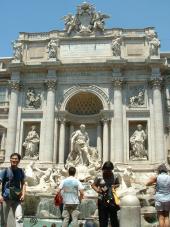 The Trevi Fountain, Rome
Photo: BPG
Ivrea Carnival
Early January
(lasts for 5 days)
In 2001 the carnival celebrated its 194th edition, but the area had started celebrating the events as early as the 1600s. The fight for liberty, when the men of Ivrea "expelled" the Marquis of Monferrato, is recreated with the Battles of the Oranges, which substitute stones. To make it fun there are several orange throwing "teams", all sporting colorful uniforms. The Carnival also has a lot of parties, food events and music.
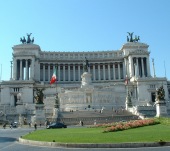 Vittorio Emanuele Monument, Rome
Photo: BPG
San Gennaro - Naples
September
San Gennaro, patron saint and protector of Napoli, stands for many as a symbol of the city itself, and his festival is one of the most passionately celebrated in all of Italy.
The festival ideally culminates in the miracle of the liquefaction of the blood of San Gennaro, which takes place every year more or less on the date of the festival. Many accept the divine nature of the event, and it is incontestable that the blood liquefies, but experts obviously differ on why or how this happens.
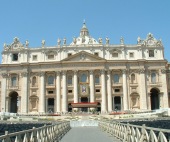 St. Peter's Basilica, Rome
Photo: BPG
Easter Sunday Florence
The annual 'holy fire' during Holy Week, is started with historical shards of the Holy Sepulchre, and is lit in the Church of SS Apostoli and transported to the Duomo, where the archbishop of the city lights the sacred 'Colombina' rocket with it during the Easter Mass. The rocket travels out of the Duomo along a wire, sets fire to the huge array of fireworks attached to the ICARRO and returns back into the church the way it came.
The celebration of the ceremony still bears a strong resemblance to the way in which it has been celebrated for centuries. On the morning of the day the Carro, pulled by two white oxen, leaves from Via del Prato for the Piazza del Duomo, accompanied by costumed revellers and various city officials and clerical representatives.
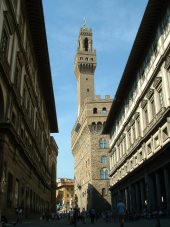 Palazzo Vecchio, Florence
Photo: BPG
The Palio delle Contrade,
Siena
July
A banner, decorated with an image of the Virgin Mary, is presented to the winner of a horse race around the Siena's Piazza del Campo. Competitors come from each one of the 17 districts of the city.
The race consists of bareback riders making three circuits of the main square and is over in 90 seconds. But it is preceded by 5 hours of flag throwing acrobatics around the main square.
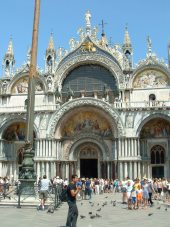 St. Marco Basilica, Venice
Photo: BPG
Viareggio
February - March
Every year The Viareggio Carnival is the most spectacular in Italy, and is known world-wide. The people of Viareggio begin preparing the huge papier-maché puppets in hangar-like buildings by the sea. The figures satirise public and political figures; making them and setting them atop the floats requires considerable technical skill as well as creativity and imagination.
The voluminous floats parade around Viareggio competing for the finest float award from 2.30pm until 9pm on the following dates: 11, 18, 25, 27 Feb and 4 March, each one carrying about 200 people in costume, as well as the huge moving, Trojan horse-like puppets, which hold people inside to manoeuvre the weights, counter-weights and levers that prevent them from toppling over.
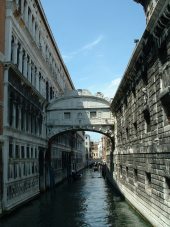 The Bridge of Sighs, Venice
Photo: BPG
|
|
|